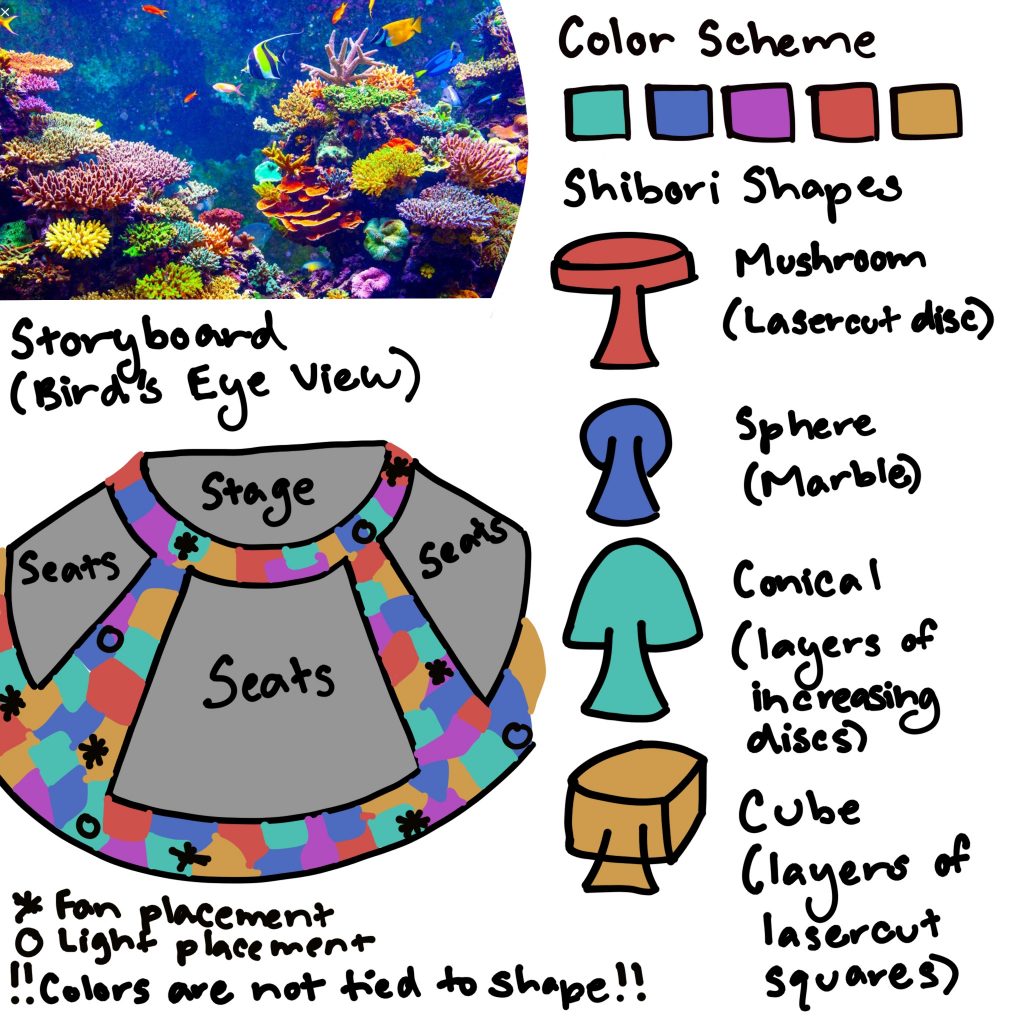Originally based off of coral reefs and underwater ecosystems, our project will involve covering the floor of Kresge Theater with hundreds of shibori dyed features that will ambiently interact with the audience for the hour long performance. Our interaction is detailed as follows:
The audience members will file into the theater, with shoes off, and will experience an negotiation as they walk across our piece – will they step all over the delicate features or will they gingerly avoid them?
As the performance begins, fans will begin to actuate the shibori pieces lightly, causing them to hover above the floor a few inches as corresponding to the music. Spotlights will cause the audience to focus on certain areas of the piece, either highlighting the squished or survived nature of the area.
Once the performance finishes, the audience will again be forced to choose whether to step or avoid the piece, but with the added emotion of having experienced the ambient existence of the shibori for the past hour.
In terms of execution, we plan to experiment with different shapes and colors (as visualized in our sketches above), as well as potentially exploring added effects caused by occasionally adding glow in the dark dye or color removers to add another layer of pattern to the shibori for visual interest. We plan to dye about 2ft x 2ft sheets of material at a time that will then be attached together (either by stitch or iron on). Thus, we will bring into Kresge already attached sheets that may be taped or pinned down to the floor of the theater. We plan to use about 7-10 small fans that will be placed around the audience, which we will need to provide digital control. The lights in the piece might either be LED rings already stitched into specific positions or external spotlights that we control accordingly.
Below we have a small visual sample of the fan movement interacting with the shibori:
Individual Assignments/Roles
Because the majority of the project will involve painstaking shibori dyeing, we will both be equally participating in this dying process and will likely separate our work by dividing what colors each one of us dye. Based on our schedule after finishing the dyeing process, we might divide the work of attaching the shibori pieces together and developing/executing the circuitry plan for the fans and lights. However, most likely, we will also be working on these goals piecewise, with both of us initial dyeing, then attaching the fabric, and then developing the circuitry interaction together.
Project Milestones
3/18 – 4/1 Shibori Dyeing our pieces
4/1 – 4/8 Attaching our shibori fabric together to create our large pieces
4/8 – 4/15 Developing our circuitry and locating placement for fans and lights
4/15 – 5/3 Refinement of interaction
Bill of Materials
- Polyester Fabric
- Rough Estimate: 150 yards (we were not able to find dimensions of the theater online)
- Found samples that showed successful shibori shape forming with polyester
- Tested the polyester shrinks around 50% after shibori dyeing
- Can reduce the area of covered by the shibori (can only cover the walk ways or the area before the stage)
- Fabric Dye
- Would probably work best with a powder dye, so we can produce variants of color and adapts well
- Would also like to experiment with color removers for additional texture on the shibori dyeing
- Would also be interested in exploring glow in the dark dye or spray paint
- Shibori Shape Forming
- Would need more marbles for feasibility of dyeing
- Would need more rubber bands for feasibility of dyeing
- Would like ~5 sheets of 2.5 ft x 2.5 ft wood from lending for lasercut shape forming
- Fabric Attachments
- We are currently unsure about the best way to attach the shibori pieces together and could use some advice about whether we should sew them together, use fabric glue, use iron-on, etc.
- Electronics
- Since we only want a small movement, we think the small orange USB fans might be sufficient for our purposes, but we might need some input here as well.
- Spotlights would be the optimum way for us to have light appear around the sample, but we aren’t sure about the feasibility of getting the spotlights.
- If spotlights are not likely, then we may use Neopixel rings that will be hooked onto external power and likely controlled using an Arduino that is connected to Max.

Leave a Reply
You must be logged in to post a comment.